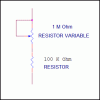im a newbie so....
i was trying to build this: DIY Time Lapse Photography | DIYPhotography.net
**broken link removed**
what are those 2 components marked SW, at upper right part? are those relays? and how are they supposed to be connected acc. to this diagram?
i was trying to build this: DIY Time Lapse Photography | DIYPhotography.net
**broken link removed**
what are those 2 components marked SW, at upper right part? are those relays? and how are they supposed to be connected acc. to this diagram?

